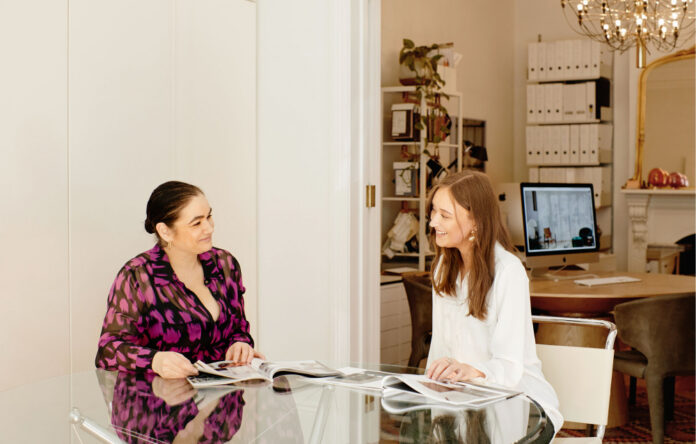[ad_1]
Chelsea Hing’s Pearls of Wisdom On Building A Successful Career in Interior Design
Words From The Wise

Interior designer Chelsea Hing (left) chats to Monash student Megan Phillips (right) about the ins and outs of the industry at Chelsea’s South Melbourne studio. Photo – Amelia Stanwix for The Design Files.

‘It’s easy to underestimate how technical interior design really is and you need to have that side of the brain in order to execute something well. You also need the other side, which is the creative. The challenge is to keep the tension between the two in some kind of balance,’ Chelsea tells Megan. Photo – Amelia Stanwix for The Design Files.

The New York-style studio of Chelsea Hing Interiors! Photo – Amelia Stanwix for The Design Files.

Chelsea at work in her home studio. Photo – Amelia Stanwix for The Design Files.

A cupboard full of swatches and materials samples. Photo – Amelia Stanwix for The Design Files.

Playing with textures, colours and lines in this serene office moment. Photo – Amelia Stanwix for The Design Files.

Chelsea in her colourful office. Photo – Amelia Stanwix for The Design Files.
With an eye for detail and an abundance of creativity, Chelsea Hing is one of Australia’s most renowned interior designers. Bursting with curiosity, in 2007, Chelsea chose to take what she had learnt from her tertiary studies and professional experience at interiors studios Nexus Design and Bates Smart and start her very own studio. Bringing joy and character into each of her projects, a Chelsea Hing interior scheme is a mixture of natural materials with splashes of expressive colours to enhance everyday living.
I, a now very inspired final year student in a Bachelor of Spatial Design at Monash University, was lucky enough to hear first-hand a fraction of Chelsea’s extensive knowledge and experience in residential interior design. I asked her about how her expectations fit the reality of the industry, and I’m feeling one step closer to starting my dream career!
Megan: Why did you choose to study interior design?
Chelsea: I originally wanted to be a lawyer. I was fascinated with ethics and philosophy… but six months in I realised it wasn’t for me.
Always creative, I went on to study design right after completing a BA, trying out different courses until I found my calling in interiors. All up, eight years in tertiary but I feel like that gave me a mature edge once I graduated.
Who inspired you when you first began your design journey and how has this changed over the years?
I was fortunate enough to work with Janne Faulkner of Nexus Designs (one of the leading women of the industry) who was in the twilight of her career when I joined. She would travel to Europe every year and come back and tell us how to shake things up to keep our ideas fresh. She was her own woman, an iconoclast really, and I learned that you have to follow your own voice, otherwise get lost in mediocrity. Her influence stood me in good stead, and the people that inspire me today are built the same way.
When you first entered the industry, did you find it was more important to make yourself stand out or fit in?
Neither, the most important thing to understand is that you’re there to learn and absorb everything. I think when you demonstrate you are curious, that is more powerful than striving to stand out for the sake of it. Once you really learn your craft, the quality of your contribution becomes more valuable. A curious mind is far better than an overconfident one.
Is your job now similar to what you dreamed it would be when you were studying? If not, what changed?
It’s nothing like you imagine, as a graduate I learned early on how to juggle ten projects at a time, all with different technical requirements, timelines and demands. It’s easy to underestimate how technical interior design really is, and you need to have that side of the brain in order to execute something well.
You also need the other side, which is the creative. The challenge is to keep the tension between the two in some kind of balance. I think that’s a timeless tension and as my role in my studio continues to change, this remains a constant.
At what stage in your career did you establish your style? How did this happen?
Not until I went out on my own, and even then it took a few years. Once I realised the wisdom of focusing solely on residential projects, I began to sharpen my vision a lot faster by solving the same problems over and over again. It hones your craft, you can’t escape it.
Over time it became obvious if I was going to play the long game I better enjoy the work and make it my own. Ultimately, we all want to be creatively fulfilled, so establishing a style is a self-interested mission, but it does pay off.
Do you have any kernels of wisdom for emerging graduates?
I’m known for a few Chelsea one-liners by now, but I would say curiosity is your greatest asset, position yourself to learn from the best early on and, fall in love with your work.
Megan is currently completing a Bachelor of Spatial Design at Monash Art, Design + Architecture. Learn more about the course here.
[ad_2]
thedesignfiles.net










